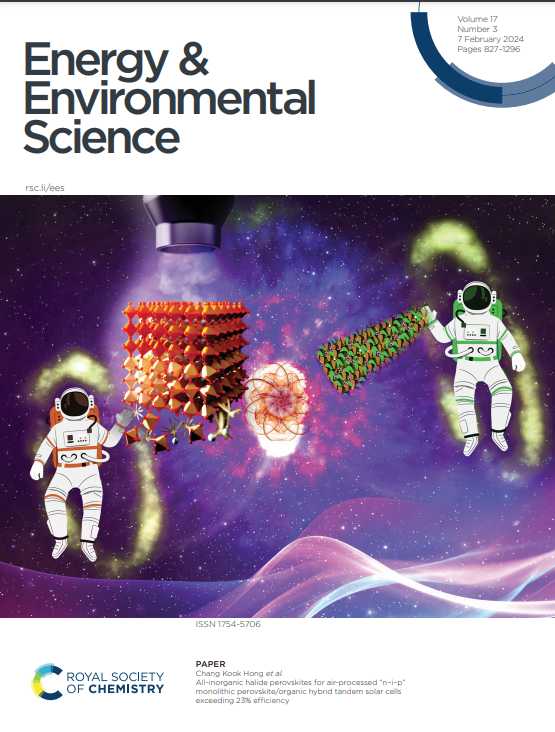Ni(OH)2上单原子钨掺杂诱导化学-电化学耦合途径实现高效尿素电氧化
IF 32.4
1区 材料科学
Q1 CHEMISTRY, MULTIDISCIPLINARY
引用次数: 0
摘要
电催化尿素氧化反应(UOR)已成为除氧反应(OER)之外的一种很有前途的废水循环利用和能源回收方法。然而,由于*COO的限速解吸和UOR与OER的竞争,NiOOH表面上传统的UOR途径受到阻碍。在这项研究中,我们提出了一种化学-电化学耦合途径,通过构建单原子w掺杂纳米多孔P-Ni(OH)2催化剂(np/W-P-Ni(OH)2)来实现直接UOR。具体而言,np/W-P-Ni(OH)2催化剂表现出优异的UOR性能,其超低电位为1.28 V,相对于RHE达到10 mA cm-2,并且在整个电位范围内具有超过90%的高UOR选择性。原位光谱和理论计算结果表明,单原子W掺杂剂不仅通过调节晶格羟基中的O电荷加速Ni(OH)O活性中间体的形成,而且还降低了质子耦合电子转移步骤的能垒和C−N键的裂解,从而实现了高效的UOR。本文章由计算机程序翻译,如有差异,请以英文原文为准。
Single-atom Tungsten Doping Induced Chemical-electrochemical Coupled Pathway on Ni(OH)2 Enables Efficient Urea Electrooxidation
Electrocatalytic urea oxidation reaction (UOR) has emerged as a promising alternative to oxygen evolution reaction (OER) for wastewater recycling and energy recovery. However, traditional UOR pathway on NiOOH surface faces is hindered by the rate-limiting desorption of *COO and the competition between UOR and OER. In this study, we propose a chemical-electrochemical coupled pathway for direct UOR, achieved through the construction of single-atom W-doped nanoporous P-Ni(OH)2 catalyst (np/W-P-Ni(OH)2). Specifically, np/W-P-Ni(OH)2 catalyst exhibits exceptional UOR performance with an ultralow potential of 1.28 V vs. RHE to reach 10 mA cm-2 and a high UOR selectivity exceeding 90% across the entire potential range. A collection of in-situ spectroscopies and theoretical calculations reveal that single-atom W dopant not only accelerates the formation of Ni(OH)O active intermediates by modulating the O charge in the lattice hydroxyl, but also lowers the energy barrier of the proton-coupled electron transfer step and the cleavage of C−N bond, thus realizing the highly-efficient UOR.
求助全文
通过发布文献求助,成功后即可免费获取论文全文。
去求助
来源期刊

Energy & Environmental Science
化学-工程:化工
CiteScore
50.50
自引率
2.20%
发文量
349
审稿时长
2.2 months
期刊介绍:
Energy & Environmental Science, a peer-reviewed scientific journal, publishes original research and review articles covering interdisciplinary topics in the (bio)chemical and (bio)physical sciences, as well as chemical engineering disciplines. Published monthly by the Royal Society of Chemistry (RSC), a not-for-profit publisher, Energy & Environmental Science is recognized as a leading journal. It boasts an impressive impact factor of 8.500 as of 2009, ranking 8th among 140 journals in the category "Chemistry, Multidisciplinary," second among 71 journals in "Energy & Fuels," second among 128 journals in "Engineering, Chemical," and first among 181 scientific journals in "Environmental Sciences."
Energy & Environmental Science publishes various types of articles, including Research Papers (original scientific work), Review Articles, Perspectives, and Minireviews (feature review-type articles of broad interest), Communications (original scientific work of an urgent nature), Opinions (personal, often speculative viewpoints or hypotheses on current topics), and Analysis Articles (in-depth examination of energy-related issues).
 求助内容:
求助内容: 应助结果提醒方式:
应助结果提醒方式:


